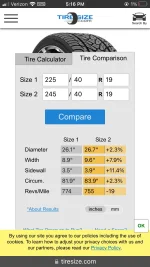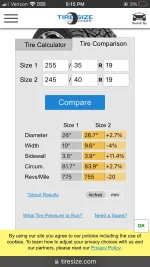Hello again. Thanks again for your previous answers. So, I am getting close to switching over to a square setup, and using all-season tires, since weather is getting colder. I am keeping in mind your previous advice to stay as close as possible to the
wheel offset as possible, especially for the front of the car. Last night, I found a website,
wheel-size.com, that lists the OEM
wheel specs for my car, a 2023 3.3T. When I go to the square setup, I am planning on using 255 35R 19 all around.
Wheel-size.com website shows the OEM
wheel sizes as follows:
Front: 8J X 19 ET 34
Rear: 8.5J X 19 ET 46.5
So, I am assuming that the ET 34 is the offset for the front
wheel, and the ET 46.5 is the offset for the back
wheel?
The website shows the offset range for the front as 32 to 36 mm
It shows the offset range for the rear as 44.5 to 48.5 mm
Also, in one of the articles I have read, it said that going to a wider
wheel could change the required offset. So my question is the following. Since the
wheel width difference between the front and the rear wheels is 0.5 inches (12.7 mm), and the difference in the ET offset value for the front and rear wheels is 12.5 mm (34 mm vs. 46.5 mm), is the 12.5 difference in the ET offset value simply due to the fact that the rear
wheel is 12.7 mm wider?
And if that is the case, would it be correct for me to buy wheels for a square setup that have a listed offset of 46.5 mm for the front and rear? Rather than buying wheels that have a listed offset of 34 mm? Or is the calculation more nuanced than that?
Thanks for your input. I really appreciate your time.









